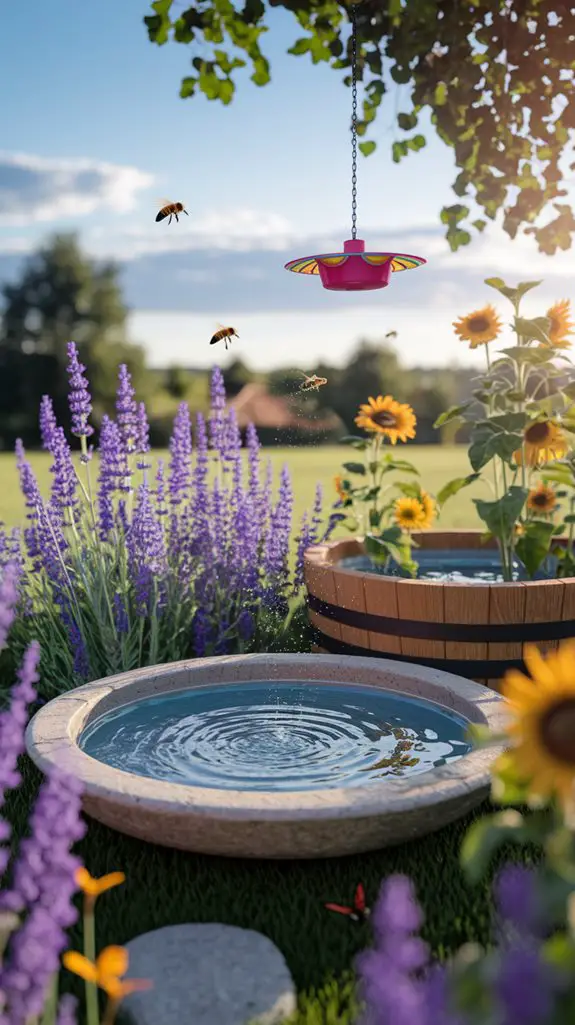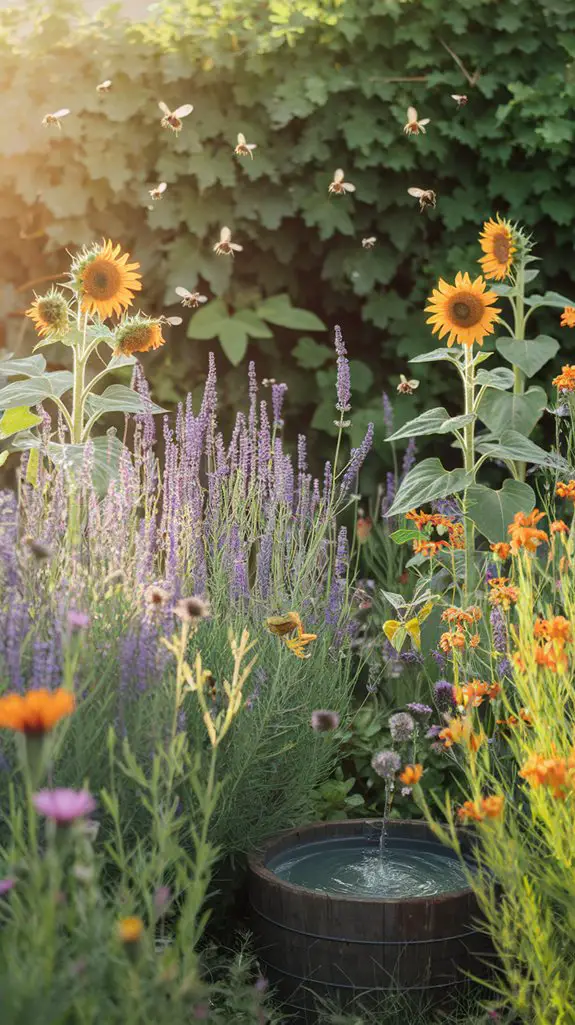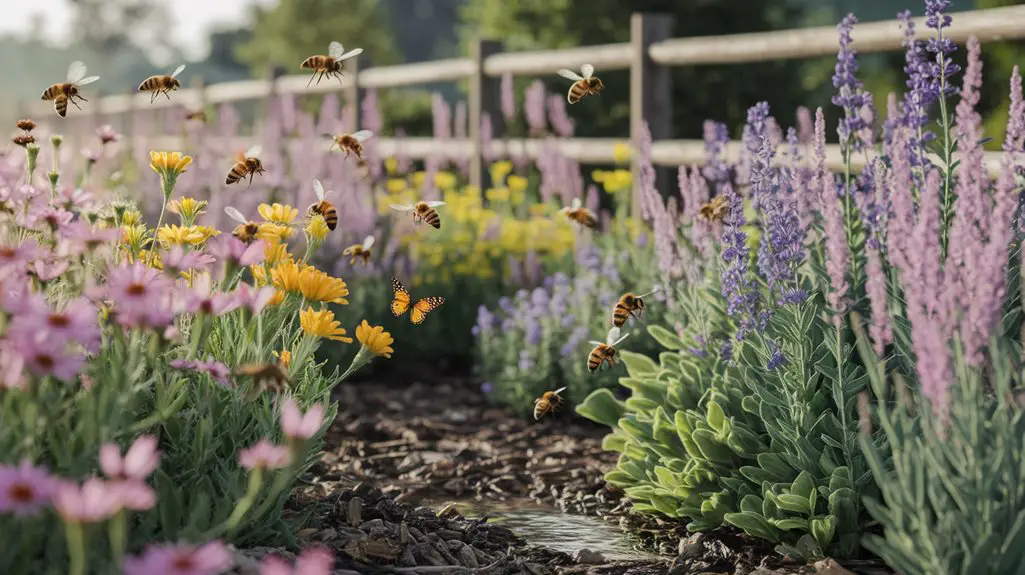You've noticed fewer bees and butterflies in your garden lately, haven't you? This decline isn't just happening in your backyard—it's a worldwide concern affecting our food security and ecosystem health. Creating a pollinator-friendly garden isn't merely decorative; it's an ecological necessity. With strategic plant selection, thoughtful design, and proper maintenance practices, you can transform your outdoor space into a vibrant haven that supports these essential creatures throughout their life cycles.
Plant Native Flowering Species
When establishing a pollinator-friendly garden, native flowering species should be your foundation. Native plants have co-evolved with local pollinator populations, providing precisely the nectar, pollen, and habitat these species require.
Select varieties that bloom in succession throughout growing seasons to guarantee continuous food sources from early spring through late fall.
Choose plants with diverse flower shapes—tubular blooms attract hummingbirds, while flat, composite flowers serve butterflies and bees effectively. Include both perennials (coneflower, bee balm) and annuals (sunflowers) for structural diversity.
Group identical plants together in clusters of at least three specimens to increase visibility to pollinators.
You'll find that native species typically require less maintenance, water, and fertilizer than non-natives while delivering maximum ecological benefit to your local pollinator communities. Additionally, incorporating habitat features such as nesting sites and water sources will further enhance the attractiveness of your garden to pollinators.
Create Water Sources for Thirsty Pollinators

Just as pollinators need food sources, they require reliable access to water for hydration and various biological processes. Installing appropriate water features enhances your garden's pollinator support infrastructure while preventing accidental drowning of these beneficial visitors. Consider implementing these effective water sources:
- Shallow dish baths – Fill a shallow container with water and place stones or marbles that protrude above the water line, creating safe landing spots for insects.
- Mud puddling areas – Maintain a small patch of damp soil where butterflies can extract essential minerals.
- Bird bath with gradual edges – Position a shallow bird bath with textured surfaces where bees and other pollinators can safely perch while drinking.
Regularly refresh water sources to prevent mosquito breeding and maintain water quality during hot weather periods. Additionally, incorporating water features can significantly increase the biodiversity of your garden, encouraging a wider range of wildlife to thrive.
Avoid Pesticides and Harmful Chemicals

While providing water sources supports pollinator health, the chemicals you apply in your garden can undermine these efforts.
Synthetic pesticides, including neonicotinoids, directly harm bees, butterflies, and other beneficial insects through both contact and ingestion. Even organic pesticides aren't completely safe for pollinators.
Adopt integrated pest management instead. Manually remove pests, introduce beneficial predators like ladybugs, and select pest-resistant plant varieties. Implementing natural pest control techniques can further enhance your garden's safety for pollinators.
If intervention becomes necessary, choose targeted biological controls rather than broad-spectrum chemicals. Apply any treatments at dusk when pollinators are less active.
Read product labels carefully—many "garden-friendly" products contain harmful ingredients.
Create buffer zones between any treated areas and flowering plants.
Design Garden Areas With Year-Round Blooms
To guarantee pollinators have continuous food sources, design your garden with sequential blooming periods that span all growing seasons.
Select plant varieties that flower at different times, ensuring nectar and pollen availability from early spring through late fall. Research native species' bloom calendars to create a thorough succession plan.
- Early Season (Spring): Plant crocus, bluebells, and redbud trees that provide essential nutrition for emerging bees and overwintered butterflies.
- Mid-Season (Summer): Incorporate coneflowers, bee balm, and milkweed varieties that thrive during peak pollinator activity.
- Late Season (Fall): Include asters, goldenrod, and autumn joy sedum to support migratory species and help pollinators prepare for winter dormancy.
Position these bloom zones throughout your garden to create continuous feeding corridors that allow pollinators to conserve energy while foraging. Additionally, consider adding pollinator-friendly herbs such as mint and thyme, which can further enhance the diversity of your garden and attract a broader range of pollinators.
Provide Shelter and Nesting Spaces
Beyond providing food sources, successful pollinator gardens must include appropriate shelter and nesting habitat that supports different species throughout their life cycles.
Dedicate undisturbed areas with leaf litter, native bunch grasses, and hollow stems for overwintering insects. Create bare soil patches for ground-nesting bees, which represent 70% of native bee species.
Install bee hotels with varied tunnel diameters (2-10mm) for cavity-nesting bees, positioning them 3-6 feet above ground with morning sun exposure. Avoid chemically treated wood.
For butterflies, provide flat rocks for basking and sheltered spots during rain. Don't forget water sources—shallow dishes with stones prevent drowning while providing necessary hydration.
During fall cleanup, leave plant stems standing and delay mulching until spring to protect overwintering larvae and pupae. Additionally, incorporating native plants can further enhance the habitat by attracting a wider variety of beneficial insects.
Conclusion
Your pollinator paradise provides purposeful protection for these critical creatures. By blending beautiful blooms, basic water basins, and beneficial chemical-free cultivation, you're creating complete habitats. Maintain multiple flowering seasons and meticulous nesting areas to maximize migration and reproduction rates. Your dedicated design doesn't just develop diverse ecosystems—it directly defends declining pollinator populations. This thoughtful transformation turns typical turf into thriving, sustainable sanctuaries.




